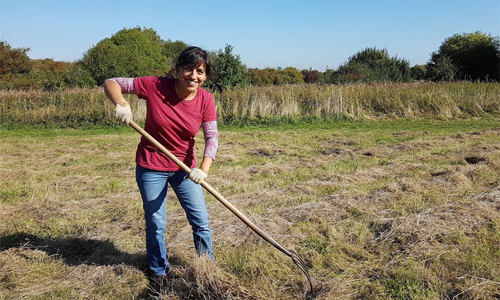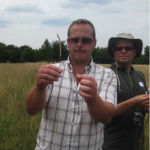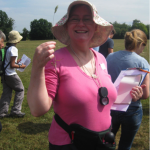Last weekend, the Biodiversity Gardens project hosted its 3rd training day of the year, entitled ‘Grasses for Beginners Training Day’. The workshop aimed at getting people to grips with a basic understanding of grassland ecology, biology and identification. Being an assistant to the course, but also very much an attendee with much to learn, I was just one of a whole group of people that day who were amazed to learn just how important grasses are to us.
Grasses are a large group of plants which belong to the family Poaceae, otherwise known as the “true grasses” and encompass c.10, 000 species worldwide, both wild and cultivated. Possibly less known to the general public is that they fall within the large group of plants, known as the angiosperms (flowering plants), which include the more ‘typical’ flowers such as daisies and buttercups with their familiar petals and sepals. The flowers of grasses are highly modified and lack the showiness of petals because they are mostly wind-pollinated and therefore invest their energies into being susceptible to the elements rather than charming a passing insect.
Although having an almost worldwide distribution and being one of the largest plant families in the world, grasses lack the appropriate interest when it comes to conservation. I was, perhaps too, a little ignorant of their importance, until I learnt about their fascinating story and how our lives are inextricably linked. If there were an organism that we should worship in the western civilisation it should be a grass. Grasses not only make up the bulk of our diet in the form of wheat, rice and maize, but they also cover the vast majority of the UK’s landscape, be it as arable land, parkland or gardens.
- Grass ID course
- Small skipper (Thymelicus sylvestris) amongst the grassland. This butterfly is dependent on grasses such as yorkshire fog (Holcus lanatus) as the main foodplant of its larval stage
- Course tutor Dave Warburton showing the difference in length of inflorescence between timothy (Phleum pratense) and smaller cat’s-tail (Phleum bertolinii)
- ‘Grasses for Beginners’ course attendee Moira looking pleased with her grass
The reason is because the quality of our grassland has been reduced. Before agricultural intensification, the majority of our grasslands existed in a semi-natural state, meaning that they still held enormous wildlife value even though they may have been used for farming. However, since the dawn of intensive agriculture, the wildlife value of our grasslands has declined due to the use of artificial fertilisers, intensive grazing, introduction of agricultural varieties and increased drainage. Because of this, many species dependent on grasslands for their survival have also declined. Bumblebees for example, are reliant on meadows for food and nesting sites and have declined severely with the intensification of agriculture. This will soon have severe consequences on us as fewer bees mean that our crops will fail to be pollinated.
So you can see exactly how our lives and grasslands are inextricably linked. The future of grasslands is now down to modern agriculture and how well government subsidies such as Agri-Environment Schemes do at restoring areas of improved grassland into semi-natural grassland.
For more information on grasses, I would recommend visiting the Grassland Trust’s website. Although sadly having entered liquidation late last year, they still have a wealth of information on grasses available on their site, including an in-depth report on the state of the UK’s grasslands.
For details on upcoming workshops and events at the Ecology Centre, please visit our webpage events. September sees our ‘Trees for Beginners’, don’t miss it!
Robin Searle,
Biodiversity Assistant.











July 30, 2013 at 5:34 pm
The course was very informative to give an overview of grasses and their use in the world. The ident at Oaks Park looking at the grasses in the meadow there was extremely helpful putting into practice what we had learnt in the morning. The weather was also perfect as the rain started just as we were finishing!
Thank you
Lysanne
August 1, 2013 at 9:46 am
Glad you enjoyed it Lysanne!
Robin.